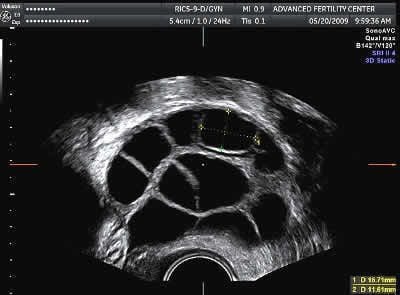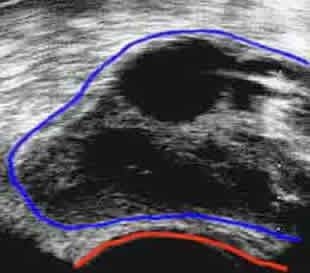IVF Egg Retrieval Procedure In vitro fertilization egg aspiration for fertility treatment
Transvaginal egg retrieval for IVF
In order to get sufficient eggs for the in vitro fertilization process, the woman is stimulated with injected medications using one of several IVF medication stimulation protocols to develop multiple follicles and eggs. The injections are usually done by the woman, or by her partner.
- Eggs develop in fluid filled structures in the ovaries called follicles
- Each follicle can be seen and measured by ultrasound and contains one microscopic egg
- The egg is loosely attached to the follicle wall
Picture of follicles for IVF ultrasound
Ultrasound photo shows multiple follicles (black structures) in a stimulated ovary
Egg retrieval process
Size of follicles for egg retrieval
- When the follicles are mature (determined by ultrasound measurements of follicle size and hormone measurements), the egg aspiration procedure is done to take the eggs out.
- About 15 to 20 mm diameter is generally consider a “mature” follicle
- More about follicle size for IVF egg retrieval
Anesthesia for egg retrieval
- Powerful anesthesia medications are given through an IV so that the woman is “out” during the egg retrieval procedure. She will not feel pain – or remember anything.
- Some clinics use other types of anesthesia, but in the US the women are generally “put to sleep” – but are still breathing on their own.
- Conscious sedation, general anesthesia and even local anesthesia can be used for this procedure.
Egg retrieval procedure
- A needle is passed through the top of the vagina under ultrasound guidance to get to the ovary and follicles.
- The fluid in the follicles is aspirated through the needle and the eggs detach from the follicle wall and are sucked out of the ovary (see video above).
- The oocyte-cumulus complex is pulled from the follicle wall when we aspirate the fluid through the needle.
- The procedure usually takes about 10 minutes at our clinic
The fluid with the eggs is passed to the IVF lab where the eggs are identified, rinsed in culture media, and placed in small drops in plastic culture dishes. The dishes with the eggs are then kept in specialized IVF incubators under carefully controlled environmental conditions.
Egg retrieval ultrasound picture
Picture of IVF egg retrieval ultrasound
Egg aspiration procedure – an egg is being retrieved from a follicle
The needle is the bright white structure on the right
Ovary outlined in blue, top of vagina in red
After egg retrieval – egg retrieval recovery
- When all of the follicles have been aspirated, the woman wakes up quickly and is monitored closely for about an hour – after which she is discharged home.
- Recovery is usually straightforward with mild to moderate cramping for a few hours or so afterwards.
- Some women will use oral pain medications (such as Vicodin) after discharge from the clinic on the day of the egg retrieval.
IVF egg retrieval numbers – how many eggs do we get with egg retrieval?
- We get about 8-12 eggs on the average at egg retrieval
- Age has an effect on the numbers – younger women give more than older women
- More details about number of eggs retrieved with IVF and age
What happens in the lab after the eggs are aspirated?
- Sperm and eggs are put together in the lab (in-vitro) about 4 hours after egg retrieval, or the sperm are injected individually into eggs. This injection process is called ICSI.
- The following morning we check the eggs for evidence of fertilization
- The embryos are cultured in the IVF lab for 2-5 more days before one or more is put into the uterus by the embryo transfer procedure.
- Fourteen days after egg retrieval we look for evidence of the good news we have all been hoping for.
- We test her blood for HCG – the pregnancy hormone



